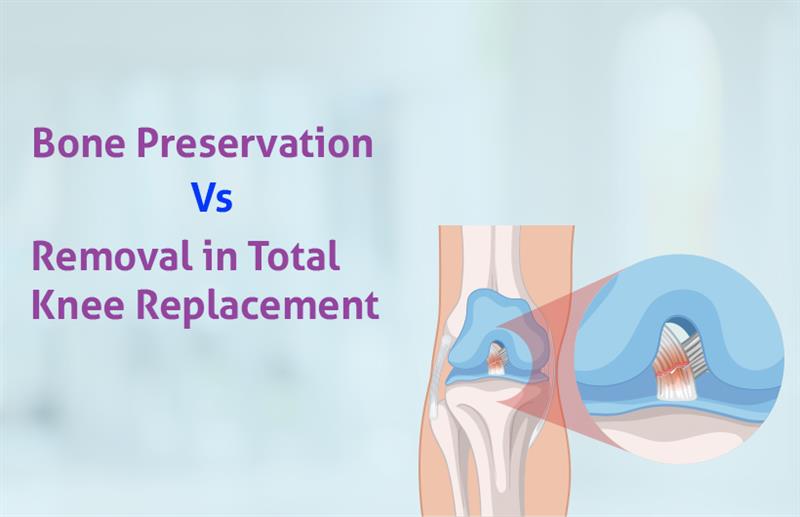Total knee replacement has become one of the most reliable solutions for people suffering from advanced knee problems, especially when pain and stiffness affect everyday life. If you are exploring this surgery, you might have come across the terms bone preservation vs. removal. These concepts are important because they determine how the surgery is performed, how much of your natural bone is kept, and what kind of implant is used.
Patients often feel confused about whether preserving more bones is better or whether removal provides a stronger foundation for implants. In this blog, let’s explore these two approaches and understand how orthopedic experts, including an experienced orthopedic surgeon in Ahmedabad, make these decisions.
Table of Contents
ToggleWhat Happens in a Total Knee Replacement?
In total knee replacement, the damaged parts of the knee joint are replaced with artificial implants. The cartilage that cushions the bones often wears away due to arthritis, injury, or ageing, leading to pain and reduced movement. During surgery, the worn-out surfaces are removed, and implants made of metal and plastic are placed to mimic natural movement.
The key decision during surgery is: how much bone should be removed and how much should be preserved? This choice is not the same for every patient. Factors like age, bone quality, knee deformity, and lifestyle are carefully evaluated by an orthopedic doctor in Ahmedabad before surgery.
Bone Preservation vs. Removal – What’s the Difference?
Bone Preservation
It focuses on keeping as much of your natural bone as possible. The surgeon reshapes only the damaged surfaces and fits the implant precisely over them. This technique is often preferred for younger patients or those with stronger bone structure because it leaves room for future revision surgeries if required.
Benefits of bone preservation include:
- Maintains more of your natural knee structure
- Easier revision surgery if needed in the future
- Preserves bone strength and stability
- May feel more natural in movement
Bone Removal
In some cases, a greater amount of bone needs to be removed to create a stable foundation for the implant. This is especially true if the damage is severe, the bone is weak, or the knee joint has a major deformity. Removing more bones ensures the implant sits securely and performs well in the long term.
Benefits of bone removal include:
- Provides a strong base for implants in severely damaged knees
- Reduces chances of implant loosening
- Corrects major deformities effectively
- Ensures better alignment and balance
An expert orthopedic surgeon in Ahmedabad carefully chooses the approach after thorough evaluation and advanced imaging tests.
Which Option Is Better – Bone Preservation or. Removal?
This is one of the most common questions patients ask before undergoing knee replacement. The truth is, there is no one-size-fits-all answer. The best approach depends on:
- The extent of knee damage
- The patient’s age and activity level
- Bone density and quality
- Presence of deformity or misalignment
- Medical history and overall health
Surgeons usually prefer preserving bone in younger patients because it keeps options open for future surgeries. For older patients or those with severe arthritis, bone removal may be more suitable to ensure long-lasting stability.
How Do Surgeons Decide the Right Approach?
Orthopedic surgeons evaluate your knee with X-rays, MRI scans, and physical examinations. They check how much cartilage has worn out, whether deformities exist, and how stable your ligaments are.
Dr. Hardik Padhiyar, renowned for his expertise in total knee replacement in Ahmedabad, carefully balances preserving bone with providing strong, durable implants. His patient-centric approach ensures that every individual receives treatment customised to their unique condition.
Is Bone Preservation Always Possible?
Not always. In some advanced arthritis cases, the bone is already weak or severely damaged, making preservation difficult. In such scenarios, removing more bones is the safer option. The goal of surgery is to restore pain-free movement and provide long-term stability, even if that means sacrificing some bone.
Does Bone Preservation or Removal Affect Recovery?
Recovery depends more on rehabilitation, muscle strength, and overall health rather than the amount of bone preserved or removed. Both approaches allow patients to walk again, climb stairs, and return to daily activities. With proper physiotherapy, most patients recover successfully and enjoy a better quality of life after knee replacement.
When considering bone preservation vs. removal, when bone preservation is possible, patients often feel the knee is closer to natural function. On the other hand, bone removal ensures the implant remains strong even in severely damaged knees.
What to Expect After Surgery?
Regardless of the chosen approach, the outcomes of modern total knee replacement are highly successful. Most patients experience:
- Reduced or no pain in the knee
- Improved walking ability
- Correction of deformity or bowlegs
- Better mobility and independence
If you are searching for a knee replacement near you, it’s important to choose a specialist who takes the time to explain these details and helps you understand which approach suits you best.
Why Consult Dr. Hardik Padhiyar?
When considering total knee replacement, you want a doctor who combines advanced surgical skills with personalised care. Dr. Hardik Padhiyar, a trusted orthopedic doctor in Ahmedabad, has extensive experience in knee replacement surgeries and focuses on delivering long-term, comfortable outcomes.
His detailed evaluation process ensures that every patient receives the most suitable treatment plan, whether bone preservation or bone removal is the right choice. With his guidance, patients can feel confident about regaining mobility and living a pain-free life.
An experienced orthopedic surgeon in Ahmedabad, like Dr. Hardik Padhiyar, provides patients with expert guidance and the best care. Whether preservation or removal is the right path, the goal remains the same: to help you walk comfortably, reduce pain, and restore your quality of life.






